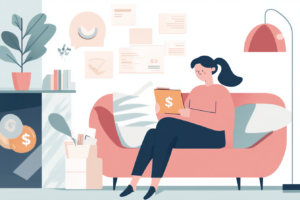Money has a remarkable quality—it can grow on its own, like a seed that flourishes into a mighty tree. This magical phenomenon is known as “compound interest,” and it’s a financial concept that has the potential to transform your wealth and financial future. If you’ve ever wondered how your savings can multiply over time, how investments can snowball into substantial sums, or simply what compound interest is all about, you’re in the right place. Continue reading to learn more about what compound interest is and how it can work for you in your financial future.
What Is Compound Interest?
When you deposit money into a savings account, the goal is to increase your balance over time. Interest is the money you earn for keeping your funds parked in a specific bank or credit union. For example, your local credit union may offer a share savings account with a 0.46% annual percentage yield (APY).
Interest is classified as either simple or compound. With simple interest, you only earn money on the amount of money you deposit. You don’t earn money on your interest earnings. Compound interest is better because it allows you to earn interest on your deposits and your interest earnings, allowing your balance to grow much faster.
Simple vs. Compound Interest
Financial terminology is easier to grasp when you have some real-life examples to review. To understand the impact of simple interest, assume that you deposit $1,000 into an account with a 5% interest rate. Since it’s simple interest, you’ll only earn money on your $1,000 deposit. Multiply $1,000 times 5% to get $50 in interest.
Now assume that your bank offers 5% interest compounded monthly. To determine your end balance, divide 5% by 12. This represents the amount of interest earned each month. In this case, an APY of 5% translates to a monthly interest of about 0.417%. Now multiply your $1,000 deposit by 0.417%. This is the amount of interest you’ll earn in the first month, or about $4.17.
Now, you need to add the $4.17 interest to your initial deposit of $1,000 to determine how much interest you’ll earn during the second month. $1,004.17 times 0.417% is $4.19. It’s only a little more, but you can see that compounding makes your balance go up faster. Continue this process for all 12 months. By the end of the year, you’ll have just under $1,051.20.
The Power of Compound Interest at Work

In the example above, you only earned about $1.20 more with compound interest than you did with simple interest. However, you started out with a small amount of money and didn’t make any additional deposits. When you start putting away a little money every month and letting it grow over time, that’s when the power of compound interest really kicks in.
Assume you start out with $1,000 and deposit $100 every month for five years. You won’t make much interest during the first year, but you’ll end up with $8,083.97 at the end of 60 months. That balance includes your $1,000 initial deposit, $6,000 in monthly deposits and $1,083.97. You’d earn more than $1,000 just by letting your money sit in the bank and rack up interest.
Now, imagine how much you could save if you started off with a $10,000 deposit. Assuming you save $100 every month and the bank pays 5% interest (compounded monthly), you’d have $19,634.20 at the end of 5 years. That’s $16,000 in contributions and $3,634.20 in interest earnings.
Compound Interest and Your Retirement Accounts
Earning a few dollars in interest isn’t all that exciting, but if you’re saving for retirement, the power of compound interest may help you earn hundreds of thousands of dollars over your working life. When you open up a 401(k) or an IRA, you get to contribute a certain amount of money each year. Your employer may also offer a contribution to your retirement account, which is essentially free money, thus helping your earnings grow even faster.
Financial markets are always changing, but it’s not unusual to earn at least 4% on your investments. Assume the following:
- You have $1,000 in your 401(k) as of January 8, 2024.
- You earn $50,000 and contribute 10% of your salary each year.
- Your employer offers a 50% match up to 6% of your total salary.
- You achieve an annual rate of return of 4%.
- You plan to retire at age 65.
In this scenario, you’d have $279,195.93 by the time you retired. This assumes your salary remains at $50,000 for the entire time. If you take a higher-paying job or get a raise, then you’d potentially earn more.
How to Maximize Your Interest Earnings
Now that you understand the power of compound interest, it’s time to maximize your earnings. One of the easiest ways to do this is to open accounts with higher-than-average interest rates. As of September 2023, banks were offering an average APY of 0.33% on standard savings accounts. With such a low interest rate, growing your savings is tough.
Consider opening a high-yield savings account (HYSA) instead. There’s no standard rate for an HYSA, but these accounts typically have a much higher APY than the standard accounts offered by banks and credit unions. For example, some banks are offering APYs of 4% to 5%.
Another way to increase your earnings is to get in the habit of saving. In the first example, you didn’t earn much interest because you never added any money to the account after your initial deposit. As demonstrated in the second example, you earn much more when you deposit more money every month.
If you hate doing your banking in person, consider automatically transferring your checking account to your savings account. Another option is to deposit checks via your bank’s mobile app instead of driving to the branch.
You might also be interested in: Crafting Diversity: A Guide To Building A Diversified Investment Portfolio







